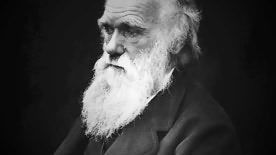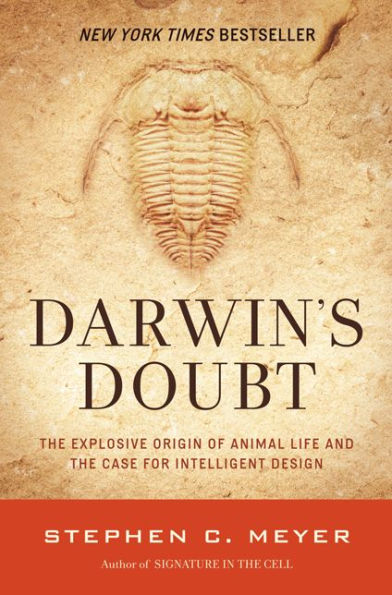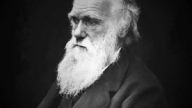Read an Excerpt
Darwin's Doubt
By Stephen Meyer HarperCollins Publishers
Copyright © 2013 Stephen Meyer
All rights reserved.
ISBN: 978-0-06-207147-7
1
DARWIN'S NEMESIS
When Charles Darwin finished his famous book, he thought that he had
explained every clue but one.
By anyone's measure, On the Origin of Species was a singular achieve-
ment. Like a great Gothic cathedral, the ambitious work integrated many
disparate elements into a grand synthesis, explaining phenomena in fields
as diverse as comparative anatomy, paleontology, embryology, and bio-
geography. At the same time, it was impressive for its simplicity. Darwin's
Origin explained many classes of biological evidence with just two central
organizing ideas. The twin pillars of his theory were the ideas of universal
common ancestry and natural selection.
The first of these pillars, universal common ancestry, represented
Darwin's theory of the history of life. It asserted that all forms of life have
ultimately descended from a single common ancestor somewhere in the
distant past. In a famous passage at the end of the Origin, Darwin argued
that “all the organic beings which have ever lived on this earth have de-
scended from some one primordial form.”1 Darwin thought that this pri-
mordial form gradually developed into new forms of life, which in turn
gradually developed into other forms of life, eventually producing, after
many millions of generations, all the complex life we see in the present.
Biology textbooks today usually depict this idea just as Darwin did,
with a great branching tree. The trunk of Darwin's tree of life represents
the first primordial organism. The limbs and branches of the tree repre-
sent the many new forms of life that developed from it (see Fig. 1.1). The
4 DARWIN'S DOUBT
vertical axis on which the tree is plotted represents the arrow of time. The
horizontal axis represents changes in biological form, or what biologists
call “morphological distance.”
Biologists often call Darwin's theory of the history of life “universal
common descent” to indicate that every organism on earth arose from
a single common ancestor by a process of “descent with modification.”
Darwin argued that this idea best explained a variety of biological evi-
dences: the succession of fossil forms, the geographical distribution of
FIGURE 1.1
Darwin's evolutionary tree of life, as depicted by the nineteenth-century German evolu-
tionary biologist Ernst Haeckel.
Darwin's Nemesis 5
various species (such as GalÃpagos finches), and the anatomical and em-
bryological similarities among otherwise highly distinct organisms.
The second pillar of Darwin's theory affirmed the creative power of a
process he called natural selection, a process that acted on random varia-
tions in the traits or features of organisms and their offspring.2 Whereas
the theory of universal common descent postulated a pattern (the branch-
ing tree) to represent the history of life, Darwin's idea of natural selection
referred to a process that he said could generate the change implied by his
branching tree of life.
Darwin formulated the idea of natural selection by analogy to a well-
known process, that of “artificial selection” or “selective breeding.”
Anyone in the nineteenth century familiar with the breeding of domestic
animals—dogs, horses, sheep, or pigeons, for example—knew that human
breeders could alter the features of domestic stock by allowing only ani-
mals with certain traits to breed. A sheepherder from the north of Scot-
land might breed for a woollier sheep to enhance its chances of survival
in a cold northern climate (or to harvest more wool). To do so, he would
choose only the woolliest males and woolliest ewes to breed. If generation
after generation he continued to select and breed only the woolliest sheep
among the resulting offspring, he would eventually produce a woollier
breed of sheep. In such cases, “the key is man's power of accumulative
selection,” wrote Darwin. “Nature gives successive variations; man adds
them up in certain directions useful to him.”3
Darwin noted that pigeons have been coaxed into a dizzying variety of
breeds: the carrier, with its elongated eyelids and a “wide gape of mouth”;
the “short-faced tumbler,” with its “beak in outline almost like that of a
finch”; the common tumbler, with its penchant for flying in close forma-
tion and “tumbling in the air head over heels”; and, perhaps strangest of
all, the pouter, with its elongated legs, wings, and body overshadowed by
its “enormously developed crop, which it glories in inflating” for its aston-
ished patrons.4
Of course, pigeon breeders achieved these startling metamorphoses by
carefully sifting and selecting. But, as Darwin pointed out, nature also has
a means of sifting: defective creatures are less likely to survive and repro-
duce, while those offspring with beneficial variations are more likely to sur-
vive, reproduce, and pass on their advantages to future generations. In the
Origin, Darwin argued that this process, natural selection acting on random
6 DARWIN'S DOUBT
variations, could alter the features of organisms just as intelligent selection
by human breeders can. Nature itself could play the role of the breeder.
Consider once more our flock of sheep. Imagine that instead of a human
selecting the woolliest males and ewes to breed, a series of very cold win-
ters ensures that all but the very woolliest sheep in a population die. Now
again only very woolly sheep will remain to breed. If the cold winters con-
tinue over several generations, will the result not be the same as before?
Won't the population of sheep eventually become discernibly woollier?
This was Darwin's great insight. Nature—in the form of environmental
changes or other factors—could have the same effect on a population of or-
ganisms as the intentional decisions of an intelligent agent. Nature would
favor the preservation of certain features over others—specifically, those
that conferred a functional or survival advantage upon the organisms
possessing them—causing the features of the population to change. And
the resulting change will have been produced not by an intelligent breeder
choosing a desirable trait or variation—not by “artificial selection”—but
by a wholly natural process. What's more, Darwin concluded that this
process of natural selection acting on randomly arising variations had
been “the chief agent of change” in generating the great
(Continues...)
Excerpted from Darwin's Doubt by Stephen Meyer. Copyright © 2013 Stephen Meyer. Excerpted by permission of HarperCollins Publishers.
All rights reserved. No part of this excerpt may be reproduced or reprinted without permission in writing from the publisher.
Excerpts are provided by Dial-A-Book Inc. solely for the personal use of visitors to this web site.







